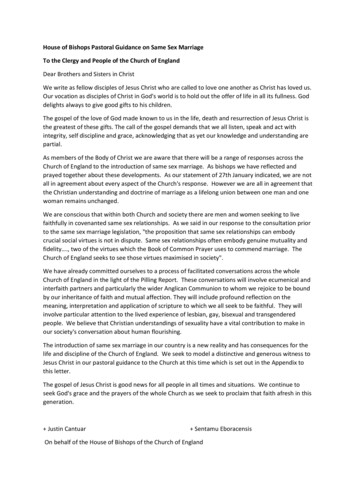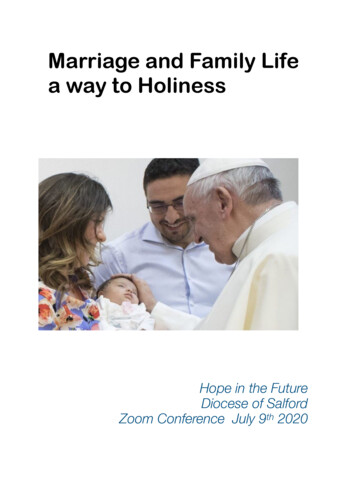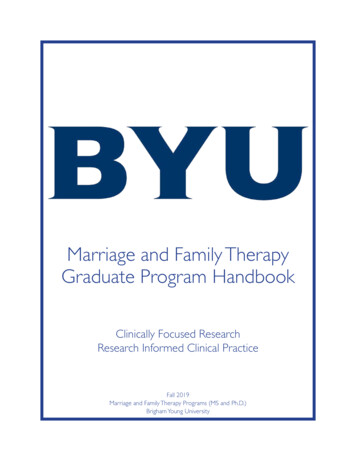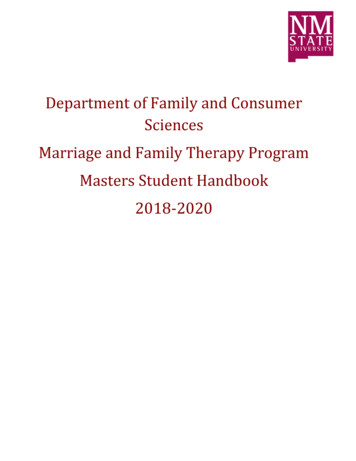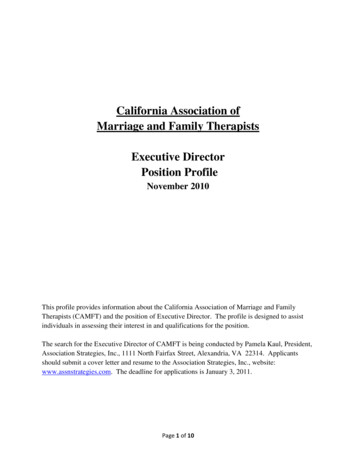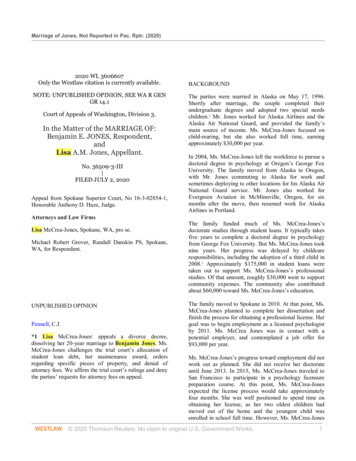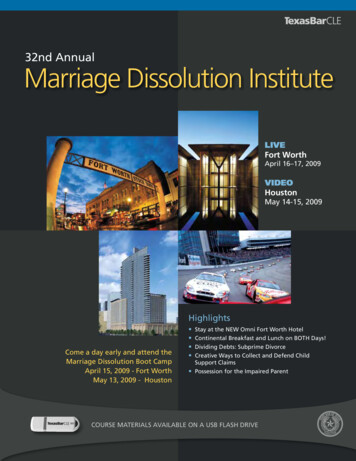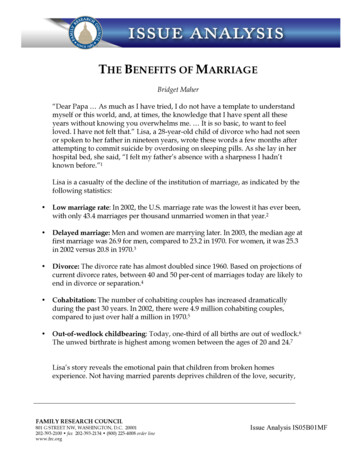
Transcription
THE BENEFITS OF MARRIAGEBridget Maher“Dear Papa As much as I have tried, I do not have a template to understandmyself or this world, and, at times, the knowledge that I have spent all theseyears without knowing you overwhelms me. It is so basic, to want to feelloved. I have not felt that.” Lisa, a 28-year-old child of divorce who had not seenor spoken to her father in nineteen years, wrote these words a few months afterattempting to commit suicide by overdosing on sleeping pills. As she lay in herhospital bed, she said, “I felt my father’s absence with a sharpness I hadn’tknown before.”1Lisa is a casualty of the decline of the institution of marriage, as indicated by thefollowing statistics: Low marriage rate: In 2002, the U.S. marriage rate was the lowest it has ever been,with only 43.4 marriages per thousand unmarried women in that year.2 Delayed marriage: Men and women are marrying later. In 2003, the median age atfirst marriage was 26.9 for men, compared to 23.2 in 1970. For women, it was 25.3in 2002 versus 20.8 in 1970.3 Divorce: The divorce rate has almost doubled since 1960. Based on projections ofcurrent divorce rates, between 40 and 50 per-cent of marriages today are likely toend in divorce or separation.4 Cohabitation: The number of cohabiting couples has increased dramaticallyduring the past 30 years. In 2002, there were 4.9 million cohabiting couples,compared to just over half a million in 1970.5 Out-of-wedlock childbearing: Today, one-third of all births are out of wedlock.6The unwed birthrate is highest among women between the ages of 20 and 24.7Lisa’s story reveals the emotional pain that children from broken homesexperience. Not having married parents deprives children of the love, security,FAMILY RESEARCH COUNCIL801 G STREET NW, WASHINGTON, D.C. 20001202-393-2100 fax 202-393-2134 (800) 225-4008 order linewww.frc.orgIssue Analysis IS05B01MF
and attention they need. Marriage provides the optimal environment for rearingchildren, the future of society. Children raised by their biological married parentsreceive numerous social, health, and economic benefits, and these gifts benefitthe whole of society. Conversely, it is through the breakdown of marriage thatchildren and society are harmed.Marriage also benefits adults by allowing them to overcome feelings of lonelinessand incompleteness by forming a complementary union. Also, it allows them topromise to give each other mutual care, respect, and protection and to raise afamily together. But the primary reason marriage is a vital institution is that itserves public purposes, namely, procreation and the benefit of children andsociety.Marriage Benefits ChildrenThere is a wealth of evidence that children raised by their biological, marriedparents have the best chance of becoming happy, healthy, and morally uprightcitizens in the future.Complementary Parental Roles: Marriage ensures that children have access to amother and a father. Mothers and fathers have unique and complementary rolesin children’s development. For example, children’s emotional bond with theirmothers helps them develop their conscience, capacities for both intimacy andempathy, and a sense of self-worth.8 One study found that adults who perceivedtheir mothers as available and devoted to them in childhood were less likely tosuffer from depression and low self-esteem as adults and more likely to beresilient in dealing with life events.9Involved fathers produce children who have better emotional health, do betteracademically, and attain higher job status as adults.10 Also, fathers teach theirchildren empathy as well as assertiveness and independence.11 But mostimportantly, fathers are role models for both their sons and daughters. Fathersteach their sons how to be a man, how to take on male responsibilities, and howto relate to women. Girls learn from their fathers that they are loveable; they alsolearn to appreciate their femininity and how to relate to men.12Less Risky Behavior: Some of the most important benefits children receive frommarried parents are love and attention. This makes them less likely to engage inbehaviors such as premarital sex, substance abuse, delinquency, and suicide. ASwedish study of almost a million children found that children raised by singleparents are more than twice as likely as those raised in two-parent homes tosuffer from a serious psychiatric disorder, to commit or attempt suicide, or todevelop an alcohol addiction.13 A 2000 study of U.S. data found that adolescents2
from single-parent families were more likely to have had sexual intercourse thanthose living with both parents.14Template for Future Marriage: Children with married parents receive a modelfor their future marriage. Children living in intact homes learn that it is possibleto entrust oneself to another person wholly for a lifetime. Also, they learn whatmarriage looks like. By their example, parents teach children about the sacrificesmarriage entails and how husbands and wives should treat each other. Childrenlearn from their parents that marriage is filled with many joys as well as sorrows,but that it’s possible to work through hardships with charity, forgiveness,patience, and perseverance.While their parents’ relationship with each other is pivotal in children’sconfidence and ability to form their own marriage, it doesn’t have to be a perfectmarriage. Judith Wallerstein, who studied 131 children of divorce over 25 years,found that children are usually “reasonably content” in an unhappy or failingmarriage.15 Children of divorce have a shattered template for marriage, causingthem to distrust marriage and to avoid it for fear of divorce. Studies have foundthat these children are twice as likely to cohabit before marriage and to divorce.16Safety Benefits: Compared to children living with single parents, childrenconceived by married parents are safer; they are less likely to be aborted17 andless likely to be abused or neglected. A 1998 study found that children in singleparent families are more than twice as likely to be physically abused thanchildren living with both biological parents.18Better Health: Children with married parents have better emotional and physicalhealth than those raised by single parents. A 2000 study from the journalPediatrics found that children from single-parent homes are twice as likely tohave emotional and behavioral problems as are children living with bothparents.19Economic Benefits: Children with married parents fare better economically. Inthe United States, poverty rates among children living with single mothers arefive times higher than those of children living with married parents (35.5 percentversus 7 percent).20 Also, children from intact families are likely to have higherpaying jobs as adults.21Higher Academic Scores: A 2003 study of eleven industrialized countries foundthat children living in single-parent families have lower math and science scoresthan children in two-parent families. The correlation between single parenthoodand low test scores was strongest among children in the United States and NewZealand.223
Better Parent-Child Relationships: A study in the Journal of Marriage and Familyfound that children living with their married biological parents spend more timewith their fathers and receive more affection and warmth from them than thoseliving with a step- or single father or a cohabiting father figure.23Marriage Benefits AdultsAdults, too, are able to enjoy the health, social, and economic benefits ofmarriage. Marriage allows men and women to form a union and raise a family,as most adults desire to marry and have children.24Better Health: Married people have better emotional and physical health thanunmarried people. A 2004 report from the National Center for Health Statisticsfound that married people are happier and healthier than widowed, divorced,separated, cohabiting or never-married people, regardless of race, age, sex,education, nationality, or income.25 Compared to people of other marital statuses,the study found that married people have the least limitations in normal dailyactivities, including work, getting dressed, remembering, and walking. They alsoexperience the lowest amount of serious psychological distress, and drink andsmoke less.26Similarly, a 2000 study found that married persons have the lowest incidences ofdiseases such as diabetes, hypertension, and heart disease.27Longer Life Span, Less Suicide: Married people live longer and are less likely tocommit suicide than those who are not married. 28 A 2000 study found thatdivorced and separated men and women are more than twice as likely as marriedpersons to commit suicide.29Greater Wealth, Higher Incomes: Married people enjoy greater wealth thanunmarried people—and the longer they stay married, the more their wealthaccumulates.30 Marriage particularly benefits men’s earning capacities. Onestudy found that married men earn about 22 percent more than men who havenever cohabited and never married.31 Another study confirmed that marriageitself is what leads to men’s higher incomes; the possibility that men with higherearning potential are more likely to marry has little impact on the “marriagepremium.”32Safety Benefits: Marriage is the safest relationship for women. A 2002 studyfound that cohabiting couples reported rates of physical aggression in theirrelationships three times higher than those reported by married couples.33 ADepartment of Justice report found that married and widowed women had thelowest rates of violent abuse by a spouse, while divorced and separated womenhad the highest rates of violence by their spouse, ex-spouse, or boyfriend.344
Marriage Benefits SocietyThe social, health, and economic gifts of marriage lead to stronger communitiesand society.Less Abortion: Marriage protects human life, as married women are less likely toabort their children than unmarried women. With fewer abortions, human life ismore likely to be respected at all stages—from tiny, defenseless embryos to frail,disabled elderly persons.Safer Homes: Marriage helps make homes safer places to live, because it curbssocial problems such as domestic violence and child abuse.Safer Communities: Communities with more married-parent families will besafer and better places to live because they are less likely to by plagued bysubstance abuse and crimes committed by young people.Less Premarital Sex: Marriage also helps to prevent premarital sex, out-ofwedlock births, and sexually transmitted diseases, because young people raisedby married parents are less likely to have sex before marriage.Less Poverty, More Wealth: The economic benefits of marriage for societyinclude less poverty and welfare dependence, because married-parent familiesare less likely to live in poverty than single-parent families. With fewer people onwelfare, governments would have a broader tax base. Along with reducingpoverty and welfare dependence, marriage generates more revenue in theeconomy since married people have higher incomes and greater wealth.Healthier Society: The main health benefit of marriage is a healthier society. Thisis because married people have better health than unmarried people andchildren with married parents are healthier than those with single, cohabiting, orstep parents. If people are healthier, health care costs will be lower.More Marriage, Less Divorce: Married-parent homes are more likely to produceyoung adults who view marriage positively and maintain lifelong marriages.Divorce, on the other hand, is likely to breed more divorce and often leads youngpeople to have negative attitudes toward marriage and to cohabit beforemarriage.35Less Government, Lower Taxes: With more strong marriages, fewer programssuch as child support enforcement, foster care, and welfare would be needed toalleviate the effects of broken homes, lessening taxpayers’ burdens. According toa recent study, divorce costs the United States 33.3 billion per year.36 Teenchildbearing costs U.S. taxpayers about 7 billion annually for increased welfare,5
incarceration, and foster care costs as well as lost tax revenue due to governmentdependency.37More Engaged Citizens: Married people are more likely than unmarried peopleto vote, volunteer in social service projects, and get involved in their churchesand schools.38Strengthening MarriageThe institution of marriage can be strengthened in a variety of ways, includingenacting laws to implement pro-family tax reform, no-fault divorce reform,welfare reform, abstinence-until-marriage programs, and premarital education.Community initiatives such as Marriage Savers have also been effective instrengthening marriage and reducing divorce.Tax Reform: Our tax system should encourage marriage, childbearing, andadoption. The marriage penalty, under which married couples pay higher taxesthan single people or cohabiting couples, should be eliminated. Legislationpassed by Congress in 2001 that provided for a gradual phase-out of this penaltywill expire in 2011; it should be made permanent. This same tax bill, combinedwith later revisions, also provided for a phased-in doubling of the per-child taxcredit, from 500 to 1,000, and a doubling of the adoption tax credit, from 5,000to 10,000. These reforms also need to be made permanent.Divorce Reform: It should become more difficult to obtain a divorce. Theunrestricted access to no-fault divorce has contributed to our high divorce rate.Today, nearly all states have no-fault divorce laws, which allow a spouse to filefor or obtain a divorce for any reason without obtaining the consent of the otherspouse, thus making the divorce process unilateral and rendering powerless thespouse who wants to preserve the marriage.Several states have tried to restrict divorce by proposing legislation or passinglaws which require mutual consent, longer waiting periods, or classes fordivorcing parents before a divorce can be obtained. In addition, three states havepassed covenant marriage laws, which give couples a choice between a standardmarriage license, which allows no-fault divorce for any reason, and a covenantmarriage license, which requires premarital counseling and longer waitingperiods or proof of fault before divorce.39The Louisiana Model: Louisiana’s Covenant Marriage Act went into effect in1997. The bill was authored by then-state representative and current FRCPresident Tony Perkins. Similar covenant marriage laws have been instituted inArkansas and Arizona, and legislation has been introduced in Indiana, Iowa,Mississippi, Missouri, Oklahoma, Texas, Utah, Virginia, and West Virginia.6
Louisiana’s covenant marriage law requires premarital counseling and placesrestrictions on no-fault divorce. The counseling covers the seriousness of covenant marriage, reinforces the notion that marriage is a lifelong commitment, andrequires the couple to commit to seek marital counseling for problems that arise.Under Louisiana law, divorce or separation may be obtained in a covenantmarriage only after a couple that has not obtained a legal separation has livedapart for two years. Couples without children who have obtained a legalseparation must wait one year before divorcing; separated couples with childrenare required to wait 18 months.Grounds for divorce or separation include proof of adultery, conviction of afelony with a sentencing to death or imprisonment at hard labor, abandonmentby either spouse for one year, physical or sexual abuse of a spouse or child of oneof the spouses, or (for purposes of legal separation only) cruel treatment orhabitual intemperance.40More work needs to be done to encourage young couples to choose covenantmarriage. A preliminary study found that covenant marriages comprise onlyabout two percent of new marriages in Louisiana.41 It has been reported thatparish clerks of court are discouraging couples from choosing covenantmarriage.42Many couples may also be unaware of the covenant marriage option. Accordingto one study, 40 to 50 percent of spouses who chose the standard marriage optionhad never heard of covenant marriage, and only 16 percent had discussed theoption.43 Those couples who chose covenant marriage have lower divorce ratesin the first five years of marriage due to more premarital counseling, lower ratesof premarital cohabitation, and wives’ strong religious beliefs.”44Welfare Reform: The breakdown of marriage is a root cause of poverty, as mostwelfare recipients are never-married or divorced mothers. When the federalgovernment sought to reform the welfare system in 1996, three of its stated goalswere to strengthen marriage, reduce out-of-wedlock childbearing, and encouragethe formation of two-parent families. Some states, such as Oklahoma, Utah,Arizona, Michigan, and Virginia, have used welfare money for pro-marriageefforts. However, other states have not acted decisively to promote marriage. In2000, less than one percent of combined state and federal welfare costs werespent on these goals.45 To remedy this, President Bush has proposed earmarking 300 million in welfare money for pro-marriage programs such as premaritaleducation classes and marriage mentoring. State and local governments as wellas private organizations can apply for the money to develop marriage programs.7
Abstinence-Until-Marriage Education: The United States government shouldadequately fund abstinence-until-marriage programs, because abstinence is theonly 100-percent-effective way to prevent out-of-wedlock pregnancy andsexually transmitted disease.There are more than 1,000 abstinence-until-marriage programs, which are veryeffective in teaching young people how to save sex for marriage. They teachyoung people the benefits of saving sex for marriage, how to have healthyrelationships, and how to set goals and make good decisions. Abstinence ispresented not merely as a solution to the problems of unwed pregnancy andsexually transmitted diseases but also as a “pathway leading to respect for one’sself and others, to healthier relationships, and, eventually, to love and happinessin marriage,” in the words of Heritage Foundation experts.46The federal government has provided some abstinence-until-marriage funding inrecent years, but comprehensive sex education and contraception programs,which assume that young people will engage in premarital sex and whichpromote contraception, receive vastly more funding in comparison. In 2002,abstinence-until-marriage programs received 144.1 million in governmentfunding, while comprehensive sex-ed programs received 1.73 billion. In otherwords government spent 12 to promote contraception for every dollar spent onabstinence education.47Premarital Education: Several states have passed premarital education laws.Florida’s 1998 Marriage Preservation Act was the first requiring high schoolstudents to receive marriage skills education. Additionally, the law gives adiscount to couples applying for a marriage license who attend a minimum offour hours of marriage preparation, allowing them to waive the three-daywaiting period before the marriage can take place.In 1999, Oklahoma passed similar legislation—reducing the marriage license feefor those who receive premarital education—followed by Maryland andMinnesota in 2001 and Tennessee in 2002. Several other states have proposedsimilar bills.Premarital education is also promoted by such organizations as Marriage Savers,which has implemented community marriage policies in 183 cities in 40 states.Community marriage policies are signed by clergy and judges who agree torequire engaged couples to undergo at least four months of marriagepreparation.Married couples trained as mentors administer the marriage preparation, whichincludes a premarital inventory test to identify a couple’s strengths andweaknesses. They continue meeting with couples after the wedding and also8
help couples in troubled marriages. A recent study found that communitymarriage policies are very effective in reducing divorce rates.48Restoring a Culture of Strong MarriagesMarriage confers many social and economic benefits on children, adults, andsociety, but it has been severely weakened by feminism, the sexual revolution,and the population-control campaign. The breakdown of marriage over the pastfour decades has resulted in low rates of marriage, high rates of divorce, out-ofwedlock childbearing, and cohabitation.America needs to restore a culture in which monogamous, lifelong marriages arethe norm and marriage between and a man and a woman is treasured as thesafest and best haven for children. Then we will have fewer children like Lisacrying out for their father’s love. Fortunately, Lisa and her father are slowlytrying to patch up their relationship. Lisa’s father called her on her birthday—forthe first time in nineteen years, and she was elated. Their restored relationship isindeed a blessing, but think how much she would have been spared if herparents hadn’t divorced. That’s why need to protect marriage. Pro-marriagepolicies—as well as community and church marriage-strengthening efforts—willhelp ensure that all children are nurtured and loved by two married parents.Bridget Maher is an analyst on marriage and family in the Center for Marriage andFamily Studies at the Family Research Council.9
Notes1Lisa Singh, “The Father Land,” The Washington Post Magazine, June 6, 2004, W17.The National Marriage Project, “The State of Our Unions 2004: The Social Health of Marriage inAmerica,” June 2004, Figure 1.3Jason Fields, “America’s Families and Living Arrangements: 2003,” Current Population Reports, U.S.Census Bureau (November 2004), Figure 5.4Bridget Maher, ed., The Family Portrait: A Compilation of Data, Research and Public Opinion on theFamily, Family Research Council, 2004, 102.5U.S. Census Bureau, “Unmarried-Couple Households, by Presence of Children: 1960 to Present,” TableUC-1, June 12, 2003.6Joyce A. Martin, et al., Births: Final Data for 2002, National Vital Statistics Reports 52, December 17,2003, 10.7Ibid, Table 18.8Brenda Hunter, Ph.D., The Power of Mother Love (Waterbrook Press: Colorado Springs, 1997) 104.9Mohammadreza Hojat, “Satisfaction with Early Relationships with Parents and Psychosocial Attributes inAdulthood: Which Parent Contributes More?” The Journal of Genetic Psychology 159 (1998): 203–220, ascited in The Family in America New Research, The Howard Center (October 1998).10Jay Teachman, et al., “Sibling Resemblance in Behavioral Cognitive Outcomes: The Role of FatherPresence,” Journal of Marriage and the Family 60 (November 1998): 835–848. Also, Timothy J. Biblarzand Greg Gottainer, “Family Structure and Children’s Success: A Comparison of Widowed and DivorcedSingle-Mother Families,” Journal of Marriage and the Family 62 (May 2000:) 533–548.11David Popenoe, Life Without Father: Compelling New Evidence That Fatherhood and Marriage AreIndispensable for the Good of Children and Society (Cambridge: Harvard University Press, 1996) 143–149.12Popenoe, 142–143.13Gunilla Ringback Weitoft, et al., “Mortality, Severe Morbidity and Injury in Children Living with SingleParents in Sweden: A Population-based Study,” The Lancet 361 (January 25, 2003): 289–295.14John S. Santelli, et al., “The Association of Sexual Behaviors with Socioeconomic Status, FamilyStructure, and Race/Ethnicity Among U.S. Adolescents,” American Journal of Public Health 90 (October2000): 1582–158815Judith Wallerstein, et al., The Unexpected Legacy of Divorce: A 25-Year Landmark Study, (New York:Hyperion, 2000) 31–35.16Jay D. Teachman, “The Childhood Living Arrangements of Children and the Characteristics of TheirMarriages,” Journal of Family Issues 25 (January 2004): 86–111. Also, Paul R. Amato and Danelle D.DeBoer, “The Transmission of Marital Instability across Generations: Relationship Skills or Commitmentto Marriage?” Journal of Marriage and Family 63 (November 2001): 1038–1051.17The Alan Guttmacher Institute, “Induced Abortion,” Facts in Brief, 2003.18Joceylyn Brown, et al., “A Longitudinal Analysis of Risk Factors for Child Maltreatment: Findings of a17-Year Prospective Study of Officially Recorded and Self-Reported Child Abuse and Neglect,” ChildAbuse & Neglect 22 (1998): 1065–1078.19Kelly J. Kelleher, et al., “Increasing Identification of Psychosocial Problems: 1979–1996,” Pediatrics105 (June 2000): 1313–1321.20U.S. Census Bureau, “Historical Poverty Tables,” Table 4, available thy J. Biblarz and Greg Gottainer, “Family Structure and Children’s Success: A Comparison ofWidowed and Divorced Single-Mother Families.”22Suet-Ling Pong, et al., “Family Policies and Children’s School Achievement in Single- Versus TwoParent Families,” Journal of Marriage and Family 65 (August 2003) 681–699.23Sandra L. Hofferth and Kermyt G. Anderson, “Are All Dads Equal? Biology versus Marriage as a Basisfor Paternal Investment,” Journal of Marriage and Family 65 (February 2003): 213–232.24Money and the American Family Survey, American Association of Retired Persons, January 23–February 21, 2000 and Gallup Poll, July 18–20, 2003.25Charlotte A. Schoenborn, “Marital Status and Health: United States, 1999-2002,” Advance Data fromVital and Health Statistics, Centers for Disease Control and Prevention (Number 351, December 15,2004).210
26Schoenborn, ibid.Amy Mehraban Pienta, “Health Consequences of Marriage for the Retirement Years,” Journal of FamilyIssues 21 (July 2000): 559–586.28Linda J. Waite and Maggie Gallagher, The Case for Marriage: Why Married People Are Happier,Healthier, and Better Off Financially (New York: Doubleday, 2000) 50–52.29Augustine J. Kposowa, “Marital Status and Suicide in the National Longitudinal Mortality Study,”Journal of Epidemiology and Community Health 54 (April 2000): 254–261.30Waite and Gallagher, 97–123.31Leslie S. Stratton, “Examining the Wage Differential for Married and Cohabiting Men,” EconomicInquiry 40 (April 2002): 199–212.32Donna K. Ginther and Madeline Zavodny, “Is the Male Marriage Premium Due to Selection? The Effectof Shotgun Weddings on the Return to Marriage,” Journal of Population Economics 14 (2001): 313–328.33Sonia Miner Salari and Bret M. Baldwin, “Verbal, Physical and Injurious Aggression among IntimateCouples Over Time,” Journal of Family Issues 23 (May 2002): 523–550.34Bureau of Justice Statistics, Intimate Partner Violence, National Crime Victimization Survey, U.S.Department of Justice, May 2000, 4–5, 11.35Paul R. Amato and Danelle D. DeBoer, “The Transmission of Marital Instability across Generations:Relationship Skills or Commitment to Marriage?” Journal of Marriage and Family 63 (November 2001):1038-1051; Also, Carole Mulder and Marjorie Lindner Gunnnoe, “College Students’ Attitudes towardDivorce Based on Gender, Parental Divorce, and Parental Relationships,” Journal of Divorce &Remarriage 31 (1999): 179–188; Also, Teachman, “The Childhood Living Arrangements of Children andthe Characteristics of their Marriages.”36David G. Schramm, “What Could Divorce Be Costing Your State? The Costly Consequences of Divorcein Utah: The Impact on Couples, Communities, and Government,” A Preliminary Report, June 25, 2003,Publication in Process, Department of Family, Consumer, and Human Development, Utah State University.37Rebecca Maynard, ed. Kids Having Kids: A Robin Hood Foundation Special Report on the Costs ofAdolescent Childbearing, The Robin Hood Foundation, New York, (1996) 19.38Corey L.M. Keyes, “Social Civility in the United States,” Sociological Inquiry 72 (2002): 393–408, ascited in The Family in America New Research, November 2002. Also, Carl L. Bankston III and Min Zhou,“Social Capital as Process: The Meaning and Problems of a Theoretical Metaphor,” Sociological Inquiry 72(2002): 285–317, as cited in The Family in America New Research, December 2002.39Bridget Maher, “Deterring Divorce,” Family Research Council, 2004.401997 Louisiana Public Act 1380.41Laura Sanchez and Steven Nock, et al., “Social and Demographic Factors Associated with CouplesChoice between Covenant and Standard Marriage in Louisiana,” available pdf/2002/2002 6.pdf42See Laura A. Sanchez, Steven L. Nock, and James D. Wright, “The Implementation of CovenantMarriage in Louisiana,” Virginia Journal of Social Policy and the Law 9 (December, 2000): 192-223.43Sanchez and Nock, et al, “Social and Demographic Factors Associated with Couples Choice betweenCovenant and Standard Marriage in Louisiana.”44Laura A. Sanchez, Steven L. Nock, et al, “Can Covenant Marriage Foster Marital Stability among LowerIncome, Fragile Newlyweds?” Paper read at the National Conference on Marriage and Family Formationamong Low Income Couples (Georgetown University; Washington DC, September 4-5, 2003).452001 TANF Annual Report to Congress, April 2002.46Shannon Martin, Robert Rector and Melissa G. Pardue, “Comprehensive Sex Education vs. AuthenticAbstinence: A Study of Competing Curricula,” The Heritage Foundation, 2004.47Melissa G. Pardue, Robert E. Rector and Shannan Martin, “Government Spends 12 on Safe Sex andContraceptives for Every 1 Spent on Abstinence,” The Heritage Foundation, Backgrounder No. 1718,January 14, 2004.48Paul James Birch and Stan Weed, et al., “Assessing the Impact of Community Marriage Policies on theU.S. County Divorce Rates,” Executive Summary, The Institute for Research and Evaluation, Salt LakeCity, Utah, April 5, 2004.2711
5 Marriage Benefits Society The social, health, and economic gifts of marriage lead to stronger communities and society. Less Abortion: Marriage protects human life, as married women are

